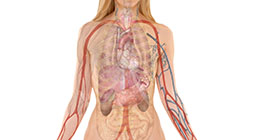
Breast Self-Examination
Breast Self-Examination (BSE) does not prevent cancer, but many women discover abnormalities in their breasts during regular home testing. Perform the exam the day after your period ends each month. Or, for non-menstruating women, pick the same day each month. Follow these instructions to perform your self-examination:
- Lie down and put a pillow under your right shoulder. Place your right arm behind your head.
- Use the finger pads of your three middle fingers on your left hand to feel for lumps or thickening in your right breast. Your finger pads are the top-third of each finger. Press firmly enough to know how your breast feels. Learn what your breast feels like most of the time. A firm ridge in the lower curve of each breast is normal. You can either move your fingers in a circle or up and down.
- Move around the breast the same way each time you do the examination so you are aware of any changes.
- Switch the pillow to your other shoulder, and repeat with your left breast, using the right-hand finger pads.
- Repeat the examination of both breasts while standing, with one arm behind your head. The upright position makes it easier to check the upper and outer parts of the breasts (toward your armpit). (You may want to do the standing part of the BSE while you are in the shower. Some breast changes can be felt more easily when your skin is wet and soapy.)
- Check your breasts for any dimpling of the skin, changes in the nipples, redness or swelling while standing in front of a mirror.
Mammogram
Every October, during Breast Cancer Month, national campaigns encourage you to “prevent” breast cancer by having your annual mammogram. A mammogram does not prevent breast cancer. It is a diagnostic tool, albeit not the most effective one, as we are discovering.
Danish researchers reviewed seven randomized, controlled mammogram trials that supported the benefits of mammography in reducing the rate of death from breast cancer. They found that, out of the seven trials, five were so flawed they could not be considered useful; the two remaining trials also had problems. Researchers determined that mammograms had no effect on reducing deaths due to breast cancer. A study published in the Journal of the National Cancer Institute (JNCI), that followed almost 40,000 women between the ages of 50 and 59 found mammograms do not reduce the death rate from breast cancer any more than a simple breast exam.
Mammogram Concerns
The chance of receiving a false positive from mammography is substantial (meaning you have been diagnosed with cancer when there is none), according to the JNCI. Women in their 40s are at higher risk of false positives due to dense breast tissue. Women who have been taking hormone replacement therapy (estrogen and progestins) have much denser breast tissue, making it difficult to detect abnormal tissue.
A study published in the Journal of the American Medical Association found that women age 70 and older had little to no benefit from regular mammograms. The Lancet reported that breast compression, which occurs during mammography, may cause tumors to rupture, spreading cancer cells.
The safety of repeated ionizing radiation from mammograms has been questioned amid concerns that they may increase the risk of breast cancer.
What’s a woman to do?
Magnetic Resonance Imaging (MRI)
Magnetic Resonance Imaging (MRI) of the breast does not use ionizing radiation. An MRI uses magnetic energy, not X-rays, to view the breast tissue. Multiple images of the breast are captured from many different angles and then combined using a computer to get a very detailed picture of the breast.
Researchers reported to the 39th Annual Meeting of the American Society of Oncology that MRI, by far, the highest sensitivity for diagnosing breast cancer—with the lowest rate of unnecessary biopsies. They found that MRIs provided 96.1 percent accuracy in reporting positive results, compared to mammography (42.8 percent accurate) and ultrasound (41 percent accurate). We need to insist on better detection methods.
Ask your doctor about MRI as an alternative to mammogram. Women should have a baseline breast MRI performed at 40 and then start annual MRIs at age 50.
Thermography
Another promising screening tool is thermography, which is less expensive and sometimes easier to obtain than an MRI.
In order to survive, a cancer tumor has to develop a supply of nutrients. In the early stages, it does this by stealing blood supply and nutrients from nearby cells. This process of angiogenesis continues until the blood cells form tiny capillaries that reach the tumor and start the supply of oxygen and nutrients that fuels rapid growth of the cancer. As the cancer grows, it forms a lump that can be felt during a clinical exam or seen on a mammogram, but, long before a lump is felt, heat is produced that can be detected via thermography.
All of this activity within the breast causes changes in the surface temperature of the skin. Thermography, or infrared imaging, is a non-invasive, painless technique that can indicate breast abnormalities, including benign tumors, cancer, fibrocystic breast disease, mastitis or other health issues, at very early stages. In fact, sensitive thermographic equipment is able to detect potential cancers at the stage where blood is pooling near the tumor site. Although thermography is not able to pinpoint the exact location of a tumor, it is extremely useful as a predictor of future cancer risks and, combined with other tests, could help prevent invasive tumor growth.
During the procedure, a woman sits in a cool room, and removes her clothing from the waist up. Although her skin temperature will drop and blood activity will slow, cancerous and precancerous cells are highly active and operate independently from the nervous system. As a result, these areas will continue to produce heat that will be captured by the sensitive infrared camera. Thermography is effective for detecting angiogenesis in dense breast tissue, so it is suitable for young women as well. Annual thermograms should become part of every woman’s breast health protection strategy, especially if you have decided not to have a mammogram or MRI.










